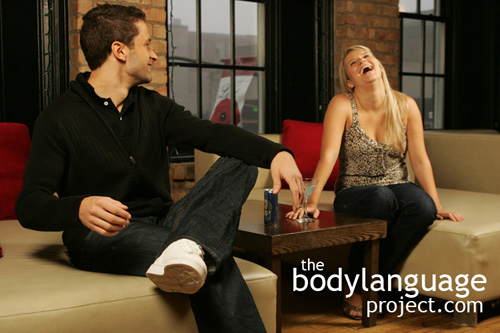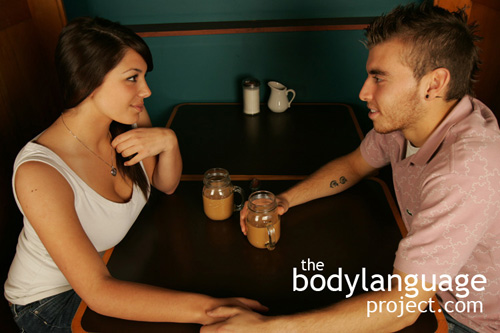
Head down with hand to mouth is a “buy signal.” She’s considering the offer.
Body language is an exciting tool and I often refer to it as such because I can use it like a wrench or screwdriver and sometimes even a hammer whenever I need it, but sometimes even just for fun. Most everyone has had some sort of fascination with body language and has thought consciously about it at one point in their life. However, not everyone will graduate from casual observer to expert or near expert, as you will by reading this book. My biased opinion is that everyone needs to read at least one book on body language, and since this is so, you might as well do it early in your life! Body language works like compound interest, the sooner you know it, the sooner you can begin to benefit from it. We will see that body language applies throughout many facets of our lives.
Certainly body language helps in sales and around the office or during an interview, but it can also help in dating, in personal relationships, and even in marriage as speak from personal experience. Understanding body language has helped me be more cognizant of my tact, or lack of thereof and has allowed me to read my wife’s mind, sometimes to our her benefit and other times, to her annoyance. To a husband, with a dry humour, who wishes to diffuse a distraught wife, pointing out his wife’s negative body language as she stands over him with her arms crossed and her head down can be amusing. It’s even more amusing to catalog her body language as it escalates when she discovers that instead of paying full attention, you’re reading nonverbal cues instead! If you explain that words are not necessary, she paints a vivid image without words, you might however, regain some respect.
Body language is useful in life because, no matter what we do, we are always dealing with people and this fact becomes even more salient when understand that everything on the planet is currently owned or controlled by someone else. That is, every piece of land, every tree, every desk, computer, television, or rock, is the property of someone else or is controlled by someone else. Therefore to acquire anything or everything you must formulate agreements with these people. Reading them becomes paramount.
Spoken language happened much later in our evolutionary history than non-verbal language and is therefore deeply rooted in our minds. Nonverbal language is primordial, primitive and therefore primary to speech. Our minds and bodies are tied together in language which is why we gesticulate while we talk. We might try to bury or ignore our body language but it still creeps out when we aren’t paying attention. For most people who have done no reading about body language at all, it is their default mode and so they show us honest gestures. This is important to us as readers because we can take these gestures more or less at face value.

An evolutionary perspective is how my framework on body language was developed.
Body language helps us predict the emotions and thoughts of the people around us and gives us a framework from which to begin to understand them, even before opening with our sales pitch or agreement, for example. My interest into body language first began in university, as I sought to learn about girls and dating. I wanted to understand what made some men more successful than others, and how, or rather if, women could be read. I was particularly interested in indicators of sexual interest. At the time, I figured the end goal was just as good as good a place to begin, as any. As I learned and studied, it became apparent that it was possible to manipulate the game all the way through and even use body language in an active way instead of a reactive way to turn the tables in my favour. My passion got me into other realms as well, such as evolutionary theory, animal behaviour and ultimately into zoology. This pulled me away from psychology somewhat, but I always had an interest in people and what made them tick. So while I studied animals, how it related to people was always at the back of my mind and helped me create my formula. I now look at life through a zoological perspective because while I was studying, psychology was just beginning to wrestle with evolutionary ideas, but hadn’t totally accepted its force and weight. This is a huge factor in why I got away from psychology and delve more and more into zoology and evolutionary theory. From the start, I knew it was the right way to look at things. My current framework would be classified as sociobiological with a high degree of favourtism toward the biological aspects, evolution in particular. I am particularly fond of primary scientific research, that is, research studies that are normally published in giant periodicals in university libraries. Now we can just grab them, and their findings, digitally through electronic files. The days of photocopying endlessly are over, but the information still needs to be properly filter, dissected and reapplied in a useful fashion by an expert of some sort. You can still get the information from the source, and if you really are keen, should, but it still needs to be interpreted to become useful, and takes a dedicated mind, because at times, it is quite dry. You’ll find this book heavily sprinkled with such primary research which makes it powerfully predictive, tested, empirical, peer reviewed, and more importantly, and as all real science should be, replicable.
By the end of my third year of university I had drafted the guts of a book about sexual body language but never took any action. It sat there for years, but I finally decided to share it with the world and publish it through the www.BodyLanguageProject.com and named it Body Language Project: Dating, Attraction and Sexual Body Language. Body language stuck with me throughout the years because once I had the basics I was always able to read people and throughout life, it really helped me. Every so often I would point out the body language of the people around me, such as my wife and friends, just to make them a little bit more aware of what they are really revealing about themselves. Other times I would read an employer, or read politicians on television, or just regular people walking about on the streets. You will see, like I did, that body language is something that once learned will stick with you for a lifetime. Most of us already have some sort of intuitive ability to read people but this book will help spell it all out for you in plain English with no need for interpretation or guesswork. Next time you read someone, you’ll be right, you won’t be guessing.
Knowing body language will be helpful while presenting to an audience, for example, since it can tell you when it’s time to make your conversation more lively, when people are truly interested, or even when it’s time to wrap it up and move on. Body language is the “intuition” that separates decent speakers from amazing ones. Good speakers will read the degree of ‘head tilt’ in their audience, which shows interest, and then know that they are onto something, or conversely watch for arm crossing, leg crossing, or both, showing withdrawal to indicating that it’s time to switch topics, switch tactics or get the audience involved. Body language can also help around the office to read your boss or if you are a boss to read your employees. Even as a parent, body language will help in reading your children and if you are married, help read your spouses hidden meaning before words set off flames.
If you have ever heard a voice recording playback, absent of video, you know how important body language is in communication and how much meaning is added through the visual channel. Monotone words strung together with no inflection showing no emotion whatsoever makes the meaning of the sentence lost and confusing. Electronic mail or instant messaging, are two wonderful examples of all that can go wrong with communication absent of body language. Text messages become confused, misinterpreted and misread, and as we all know, often end badly, sometimes so badly, it’s irreversible. Message boards also suffer in this way, often resorting to massive infighting simply because the intended meaning is lost. Emotional icons (emoticons) such as ‘smiley faces’ and ‘winks’ we now dot our messages with are good indication of the importance nonverbal cues.
Speech takes meaning from our actions and body positions, not just from resonance, frequencies and pitch carried through air molecules. When people speak, we can tell their emotions by how they use their hands, which words they emphasize, and where they pause in speech. On the other hand, to become more effective speakers we also need to be better at delivering proper body language so again we need to understand the nonverbal channel. This book is a good start on your way to learning body language, but certainly not the finish line. You will still be required to advance a significant effort independent of this book to become proficient at both reading and delivering nonverbal messages, not the least of which will happen by seeing it in real life and in real time.





